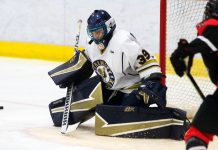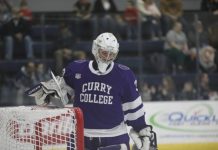There was a story in Thursday’s Wall Street Journal that highlighted the New York Rangers’ proclivity for shot blocking.
As I read the story, which was really well written by Kevin Clark, something clicked. We need to eliminate players from dropping down to block shots to improve offense in college hockey.
With the new rules to emphasize offense, the game is better. Coaches are really bright, especially in U.S. college hockey, and they will always find a way to counter rules that crimp their ability to play well defensively. As they read this, some will probably want to tell me to stop writing and not say this on TV … but, if you want to keep improving the game offensively you need more shots on goal. If you want to reap the benefits of the rules standard that promotes more skating and offense, to reap the benefits of more power plays, then it is time to make the goalies stop the puck.

Watching a ton of hockey every week for professional reasons, it just amazes me how many great offensive plays end up in shin guards or the side of someone’s hockey pants. Equipment is so good these days that no one flamingoes any more, and even your leading scorer, your softest player and your offensive-minded defensemen are dropping down and blocking shots because they know they won’t get hurt.
For $600, you can have a mold made of a solid protective cast-type material that you tie into your skate laces to protect the top of your feet. Most, if not all, NHL defenseman are wearing them. For $60, you can use non-molded ones which might not fit as well but still work.
Shin guards are so protective now and are half the size of the goalie pad-style ones worn by Craig Ludwig at the end of his career, and protect twice as well. Heck, they don’t even give off as big a rebound as the goalie pads of today.
My idea is simple. You don’t take shot blocking out completely. In all honesty, there are more than a few players out there that can’t help but being in the way of a shot due to lack of mobility or good positioning. The rule would be that you can’t go down to block a shot (which used to be a rule for goalies in the NHL in the very early years of the league).
You can still deflect a shot by going blade on blade but you can’t sprawl in front of one. You can still stay in a shot lane and force a shot wide or even block it with your body but can’t go down.
The most popular technique now is the one-leg-down shot block, and it is really effective. Watch a team like Maine and you’ll see why it works so well. As the defending player, you’ll front the shooter and turn slightly, drop one leg down and “get big,” meaning you won’t be face to puck but more side of body to puck. You increase your width quite a bit and wherever the puck hits, you are basically covered.
In the wording of the rule it must be made clear that you cannot leave your feet in any way — one foot, two feet, etc. — to block a shot. You must remain on your skates, blades on the ice, when you go to block a shot.
The exception to the rule is “the slide.” The slide is a move used by a defenseman usually on a two-on-one situation where, as the players get closer to the net and the forward tries to pass to his partner for a quick shot, the defender lays out and blocks the passing lane. It is a terrific play and many NCAA defensemen do it well. That, to me, is part of playing good defense and is more a pass block than a shot block. This one falls into a very gray area and would need to be discussed. If it has to go, it goes.
It is a small rule change, one that has been discussed by the rules committee. If the NCAA rules committee has shown anything, it has shown that is willing to listen to ideas to make the game better and more exciting. It has done a lot to make it a more offensive-minded game and a better product. There are progressive thinkers on that committee and this could be an interesting discussion once again if enough coaches, players, fans and media get behind the idea.
This once was the rule in college hockey and it goes way back. This might be an idea to try next exhibition season.
Some other thoughts:
- New coaches in new places have made a difference. Bowling Green might not be winning a ton of games but it is playing hard and starting to play a little smarter under first-year coach Chris Bergeron.
Bergeron brought a winning pedigree to Bowling Green and has quickly put his imprint on the program in the compete level. In an early season game against Michigan on a Saturday night they actually outplayed Michigan and if they had a higher skill level and converted some chances they might have upset the Wolverines. The Falcons, when they want to ramp it up, will be a tough 60 minutes. Under Bergeron, that should be a pretty common theme all season.
- Western Michigan coach Jeff Blashill has the Broncos going in the right direction and, like Bergeron, comes from a successful program at Miami. In a sweep of Michigan State at Lawson Arena last weekend the Broncos overcame a two-goal deficit Friday to win and controlled the game most of Saturday against the deeper Spartans.
Western also has seen a spike in the compete level and has some jam in its game. This is a program that made some behind-the-scenes changes in key player development areas and is also on the rise.
- Mark Osiecki gets a good test this weekend as he brings Ohio State to Michigan State for the weekend, but the Buckeyes are also another team that is playing hard and John Albert looks like he has found another gear.
Keep an eye here, because if Osiecki can recruit to OSU as a head coach the way he recruited to Wisconsin as an assistant, then the Buckeyes will be more than a football/basketball school in the near future.
- Nice job by the officials so far this season with the hybrid icing rule, and especially with the contact-to-the-head rule. There was a ton of worry that too many contact-to-the-head calls would elicit the game DQ call with it is as opposed to just the game misconduct call.
In the 25 or so games I have seen this has been called very well, most calls ending with the misconduct and not the DQ, and when you watch it back on replay the video is showing the striped to be right.
- Looking for a team to go and watch and be really entertained? Go check out Yale. Yes, the Bulldogs made the national tourney the past couple of seasons but they are still somewhat under the radar even as the No. 3 team in the nation.
They lost a few key guys to graduation this offseason but they are still flying. They have speed, they can hit, they can score, and they keep the puck moving. In a recent untelevised game against Brown, they needed only 24 minutes of actual time to play a 20-minute period.
They stay onsides, they rush the puck, they defend well and they are a fun watch. Kevin Peel is becoming my favorite NCAA defenseman. If this style is the one coach Keith Allain is bringing with him to Team USA for the World Junior Championship in Buffalo, N.Y., (Dec. 26-Jan. 5), American hockey fans are in for a treat.



